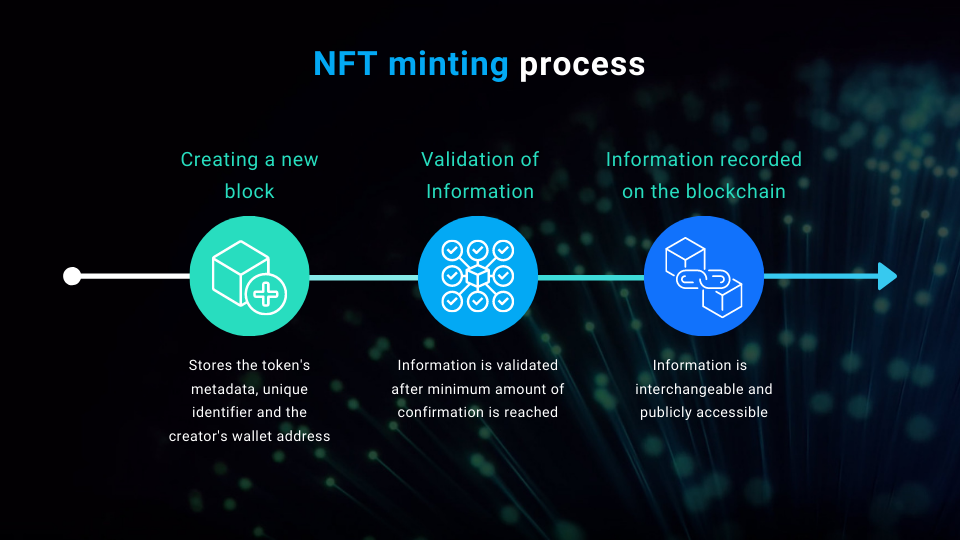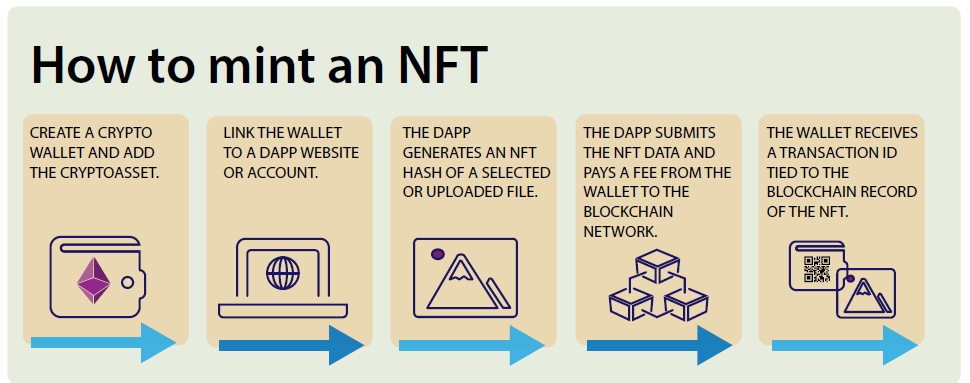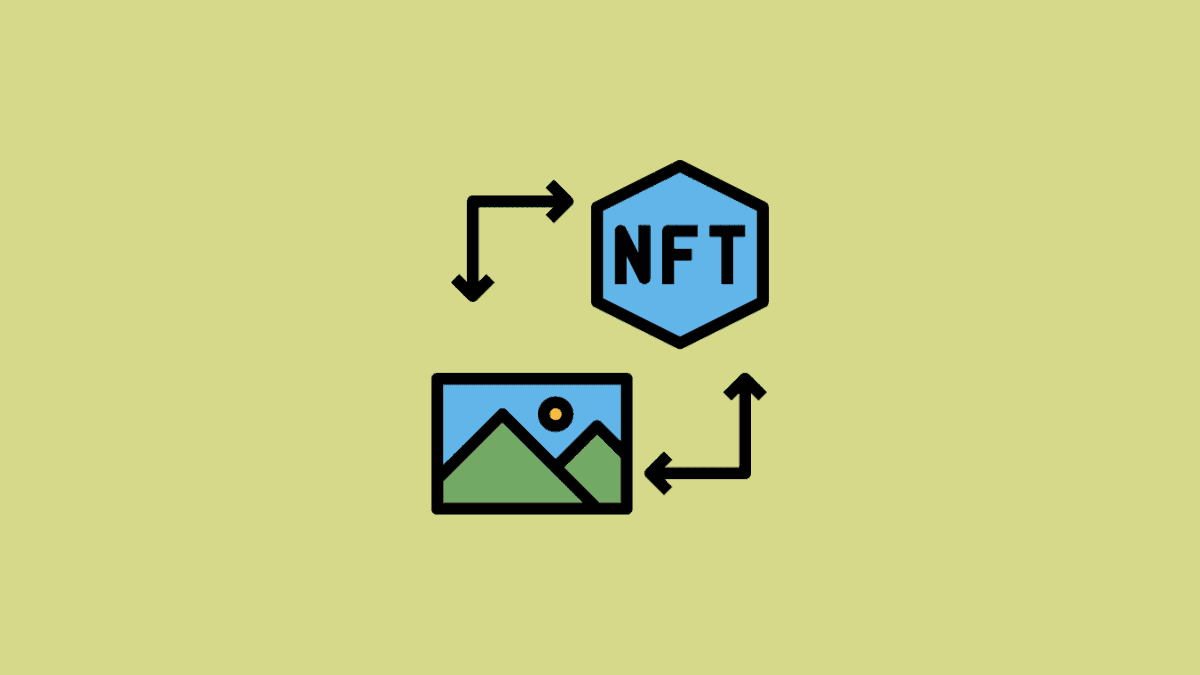NFT Minting Process - Getting Started With Digital Collectibles
NFT minting process: Learn to tokenize digital assets, set royalties, and navigate platforms efficiently.
Author:Stefano MclaughlinReviewer:Camilo WoodFeb 12, 202411.1K Shares165.9K Views

The NFT minting processis a crucial step in creating and launching non-fungible tokens (NFTs), which represent unique digital assets on a blockchain. Minting an NFT involves tokenizing a digital asset, such as artwork, music, videos, or other digital content, and recording its ownership and metadata on a blockchain.
What Does NFT Minting Mean?
Writing a digital object to the blockchain is known as "minting an NFT." This proves its unchangeable ownership and authenticity record. Typically, this process entails adding metadata to the NFT, which can contain the content's description, the creator's information, and other pertinent characteristics. By establishing ownership and provenance on the blockchain, minting guarantees the legitimacy and uniqueness of the digital asset.
NFTs can be minted by both producers and collectors. Minting NFTs establishes confirmed ownership and ownership history, which benefits both makers and collectors. In addition to giving creators ownership and control over their own creations, minting their own NFTs enables them to create exclusive communities and benefits for NFT holders.
Since the NFT is recorded on the blockchain during the mint, the person who mints an NFT from a project, either the creator or a collector, becomes the NFT's initial owner.
In this detailed exploration, we'll delve into the NFT minting process, covering its key components, steps, and considerations.
Selecting A Platform
The first step in the NFT minting process is selecting a platform or marketplace to mint and sell the NFT. There are numerous platforms available, each offering different features, pricing models, and levels of customization. Some popular NFT marketplaces include OpenSea, Rarible, SuperRare, and Foundation. Artists and creators should research and evaluate different platforms to find one that aligns with their goals and requirements.
Preparing The Digital Asset
Once a platform is chosen, the next step is preparing the digital asset to be tokenized as an NFT. This involves ensuring that the digital asset meets the platform's guidelines and specifications, such as file format, size, and quality. Artists may need to create high-resolution versions of their artwork or optimize digital files for efficient storage and display on the blockchain.
Creating Metadata
Metadata plays a crucial role in providing context and information about the NFT, including its title, description, creator information, and any relevant tags or keywords. Artists should carefully craft metadata to accurately represent their artwork and engage potential buyers. Metadata helps potential buyers discover and evaluate NFTs, so it's essential to provide detailed and compelling information.
Connecting A Wallet
To mint an NFT, creators need to connect a cryptocurrency wallet that supports the blockchain network used by the NFT platform. Popular blockchain networks for NFT minting include Ethereum, Binance Smart Chain, and Flow. Creators should ensure that their wallet is funded with the necessary cryptocurrency (e.g., ETH for Ethereum-based NFTs) to cover gas fees and minting costs.
Make Sure Your Wallet Is Funded
The network must perform certain processing in order to sell an NFT, which is a blockchain transaction record between two parties. There will be a financial charge associated with such transaction, called a "gas fee." Be mindful of the necessary transaction fees, since some can surprise you with their large cost.
Make sure you've bought some Ethereum (or whatever cryptocurrency you intend to use) on a cryptocurrency trading app and deposited it into your wallet before completing your first sale.
You can then move the cryptocurrency from your wallet to your NFT marketplace account, depending on the marketplace. By establishing a payment method, such as a credit card, you can buy cryptocurrency straight from your marketplace profile on certain marketplaces, such as OpenSea.
Setting Pricing And Royalties
During the minting process, creators have the option to set pricing for their NFT and specify royalty percentages for secondary sales. Creators can choose between fixed prices, auction-style sales, or a combination of both. Additionally, creators can earn royalties each time their NFT is resold in the secondary market, providing a source of ongoing income.
Manage Your NFT Business
After creating and listing your NFT for sale, it's time to start interacting with possible customers. Additionally, you may make more NFTs and include them in a collection to draw in the interest of art speculators and collectors. NFTs manufactured on one marketplace may also be moved to another and sold there, but there may be costs associated.
Building rapport with users and collectors on NFT marketplaces, as with other online activity, can aid in the development of your new NFT business. constantly an eye on how people are interacting with your works, seek out criticism, and constantly producing new art that online collectors may buy.
Legal And Copyright Considerations
Creators should be mindful of legal and copyright considerations when minting NFTs, especially if they are tokenizing copyrighted works or collaborating with other creators. It's essential to obtain appropriate permissions and licenses for any third-party content used in NFTs and to ensure compliance with intellectual property laws and regulations.
NFT Minting Process - FAQs
What Exactly Is Minting An NFT?
Making a distinct token on a blockchain is known as minting an NFT. An NFT is not saved on the blockchain until it has been minted. Understanding what is being stored throughout the minting process is crucial.
How Do I Mint An NFT?
To mint an NFT, you need to select a platform, prepare your digital asset, create metadata, connect a cryptocurrency wallet, and follow the platform's instructions for minting the NFT.
What Platforms Can I Use To Mint NFTs?
There are numerous platforms available for minting NFTs, including OpenSea, Rarible, SuperRare, Foundation, and many others. Each platform offers different features, pricing models, and levels of customization.
What Is Metadata In The Context Of NFTs?
Metadata refers to information about the NFT, such as its title, description, creator information, and any relevant tags or keywords. Metadata helps potential buyers discover and evaluate NFTs.
How Do I Set Pricing And Royalties For My NFT?
During the minting process, you can set pricing for your NFT and specify royalty percentages for secondary sales. You can choose between fixed prices, auction-style sales, or a combination of both.
Can I Transfer Ownership Of My Minted NFT?
Yes, once minted, NFT owners can manage and transfer ownership of their tokens using their connected cryptocurrency wallet. Owners can transfer NFTs to other wallet addresses, list them for sale on NFT marketplaces, or display them in digital galleries and collections.
How Much Does It Cost To Mint 1 NFT?
The average cost to create a nonfungible token (NFT) is between $0.05 to over $150. The price of blockchain, gas, marketplace account, listing, and other fees are only a few of the variables that affect the price of generating NFTs. The most costly and least expensive blockchains are Ethereum and Solana, respectively.
Conclusion
The NFT minting process involves several key steps, including selecting a platform, preparing the digital asset, creating metadata, connecting a wallet, minting the NFT, setting pricing and royalties, promoting and marketing the NFT, managing ownership, understanding gas fees, and addressing legal considerations. By following these steps and leveraging the capabilities of blockchain technology, creators can tokenize their digital assets as NFTs and participate in the growing ecosystem of digital collectibles, art, and culture.

Stefano Mclaughlin
Author

Camilo Wood
Reviewer
Latest Articles
Popular Articles

